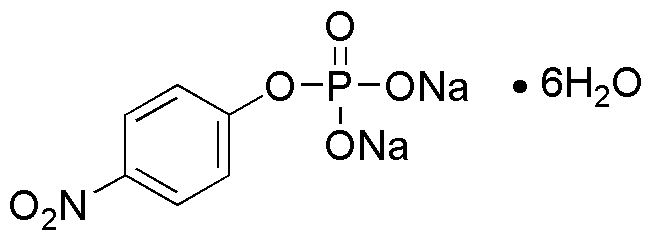4-Nitrophenyl phosphate disodium salt hexahydrate is widely utilized in research focused on:
- Enzyme Activity Studies: This compound serves as a substrate in assays to measure the activity of phosphatases, helping researchers understand enzyme kinetics and mechanisms.
- Biochemical Research: It is used in various biochemical experiments to investigate the role of phosphate groups in cellular processes, particularly in signal transduction pathways.
- Pharmaceutical Development: The compound aids in drug formulation studies, particularly in assessing the stability and solubility of phosphate-containing drugs.
- Analytical Chemistry: It is employed as a standard in chromatographic methods to quantify phosphates in environmental samples, ensuring accurate monitoring of pollution levels.
- Educational Purposes: This chemical is often used in academic laboratories to demonstrate principles of organic chemistry and enzymatic reactions, enhancing student learning experiences.
General Information
Properties
Safety and Regulations
Applications
4-Nitrophenyl phosphate disodium salt hexahydrate is widely utilized in research focused on:
- Enzyme Activity Studies: This compound serves as a substrate in assays to measure the activity of phosphatases, helping researchers understand enzyme kinetics and mechanisms.
- Biochemical Research: It is used in various biochemical experiments to investigate the role of phosphate groups in cellular processes, particularly in signal transduction pathways.
- Pharmaceutical Development: The compound aids in drug formulation studies, particularly in assessing the stability and solubility of phosphate-containing drugs.
- Analytical Chemistry: It is employed as a standard in chromatographic methods to quantify phosphates in environmental samples, ensuring accurate monitoring of pollution levels.
- Educational Purposes: This chemical is often used in academic laboratories to demonstrate principles of organic chemistry and enzymatic reactions, enhancing student learning experiences.
Documents
Safety Data Sheets (SDS)
The SDS provides comprehensive safety information on handling, storage, and disposal of the product.
Product Specification (PS)
The PS provides a comprehensive breakdown of the product’s properties, including chemical composition, physical state, purity, and storage requirements. It also details acceptable quality ranges and the product's intended applications.
Certificates of Analysis (COA)
Search for Certificates of Analysis (COA) by entering the products Lot Number. Lot and Batch Numbers can be found on a product’s label following the words ‘Lot’ or ‘Batch’.
*Catalog Number
*Lot Number
Certificates Of Origin (COO)
This COO confirms the country where the product was manufactured, and also details the materials and components used in it and whether it is derived from natural, synthetic, or other specific sources. This certificate may be required for customs, trade, and regulatory compliance.
*Catalog Number
*Lot Number
Safety Data Sheets (SDS)
The SDS provides comprehensive safety information on handling, storage, and disposal of the product.
DownloadProduct Specification (PS)
The PS provides a comprehensive breakdown of the product’s properties, including chemical composition, physical state, purity, and storage requirements. It also details acceptable quality ranges and the product's intended applications.
DownloadCertificates of Analysis (COA)
Search for Certificates of Analysis (COA) by entering the products Lot Number. Lot and Batch Numbers can be found on a product’s label following the words ‘Lot’ or ‘Batch’.
*Catalog Number
*Lot Number
Certificates Of Origin (COO)
This COO confirms the country where the product was manufactured, and also details the materials and components used in it and whether it is derived from natural, synthetic, or other specific sources. This certificate may be required for customs, trade, and regulatory compliance.

